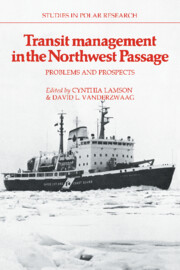Book contents
- Frontmatter
- Contents
- List of figures
- Acknowledgments
- PART I PERSPECTIVES ON THE PROBLEM
- 1 The Northwest Passage: a contrast of visions
- Post scriptum
- 2 The environment of the Northwest Passage
- 3 The development of Northern ocean industries
- 4 Arctic marine transport and ancillary technologies
- 5 Canadian arctic marine transportation: present status and future requirements
- 6 Northern decision making: a drifting net in a restless sea
- 7 Constitutional development in the Northwest Territories
- PART II PARADIGMS AND PROSPECTS
- APPENDIX: Statement on Canadian sovereignty
- CONTRIBUTORS
2 - The environment of the Northwest Passage
Published online by Cambridge University Press: 26 March 2010
- Frontmatter
- Contents
- List of figures
- Acknowledgments
- PART I PERSPECTIVES ON THE PROBLEM
- 1 The Northwest Passage: a contrast of visions
- Post scriptum
- 2 The environment of the Northwest Passage
- 3 The development of Northern ocean industries
- 4 Arctic marine transport and ancillary technologies
- 5 Canadian arctic marine transportation: present status and future requirements
- 6 Northern decision making: a drifting net in a restless sea
- 7 Constitutional development in the Northwest Territories
- PART II PARADIGMS AND PROSPECTS
- APPENDIX: Statement on Canadian sovereignty
- CONTRIBUTORS
Summary
To describe the environment of the Northwest Passage fully in a single chapter is perhaps an impossible task. The Passage, broadly defined, cuts across five time zones and includes at least seven distinct ocean regions – the Beaufort Sea, Amundsen Gulf, Prince of Wales Strait, Viscount Melville Sound, Barrow Strait, Lancaster Sound, Baffin Bay and Davis Strait. Volumes would be required to describe in any detail the environmental characteristics of these diverse regions.
By necessity, then, this chapter is much like an impressionistic painting. Only the broadest strokes may be applied to the canvas. Section I provides an overall framework for viewing the marine environment of the Northwest Passage by looking at the Arctic Ocean as an international concern, by examining Canada's major environmental protection initiatives, and by raising the need for a Northern conservation viewpoint. Section II explores the physical environment of the Passage through three lenses, bathymetry and currents, ice distribution and characteristics, and the location of recurring polynyas (open water areas). Section III highlights the biological environment from five perspectives: Arctic marine productivity, marine and anadromous fish, seabirds, marine mammals, and biologically significant areas. Section IV reviews the human setting by describing the circumpolar Inuit and the importance of renewable resource harvesting from marine waters. Section V concludes by summarizing the environmental issues raised by Arctic resource development and marine cargo transportation.
- Type
- Chapter
- Information
- Transit Management in the Northwest PassageProblems and Prospects, pp. 8 - 64Publisher: Cambridge University PressPrint publication year: 1988



